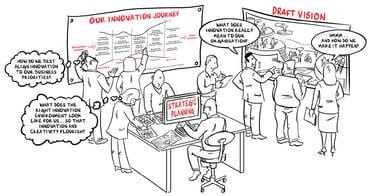What good could possibly come out of failure?
Harrison Ford was a failure as an actor for years. Twelve publishers turned down J.K. Rowling's manuscript for Harry Potter. A recording company (no doubt an ancestor of those book publishers) turned down the first Beatles album. Viagra, penicillin, pacemakers, and the smallpox vaccine were all born out of failures.
Now, let's ask again -- what good can come out of failure? Failure is actually an important, perhaps even crucial, ingredient for success. The primary difference between innovators who are successful and those who are not is the ability to fail and to leverage that failure into a learning tool for success. As the founder of Honda, Sochiro Honda, said, "Success is 99% failure." He should know; his vehicles hold their resale value better than any other vehicles on the road today.
Producing Results Versus Innovation
If your company is rewarding only success, you have effectively killed any chance that you will become a force for innovation. Punishing failure stops anyone from taking the risks necessary to succeed with innovation. It is only through failing that you learn to get outside the box and find the ingredients for innovation that everyone else is missing. As the poet and novelist James Joyce once put it, "Mistakes are the portals of discovery". When you pass through a smart failure, which we'll dissect in a moment, you find pathways to success that you just couldn't see from the other side. Here's how it works.
There's often a tendency to hyper-focus on results. Results aren't always the best indicators of whether the innovation strategy is working. For instance, in football, the coach can't teach the players how to win. What he teaches are the solid foundations of a good game -- strength, endurance, accuracy, reading other players -- and when the players apply these foundational techniques to their play, the wins start coming.
The same can be said of a creative writing instructor, or a piano teacher, or an innovation manager. Learn to put all of the pieces of innovation together -- brainstorming, collaborating, thrashing out the pros and cons of an idea, idea development, project management, etc. Sometimes this will produce success. More often, it will deliver a failure. But if the foundational techniques are done right, those failures will produce reasons for the failure. With those reasons come a path to eventual success.
Does Your Innovation Strategy Reward Good Failures?
Obviously, the flip side of this coin is wallowing in failure and bankrupting your company. No business can survive indefinitely by writing blank checks to an innovation team that religiously spits out expensive failures. There has to be some success stories along the way, if for no other reason, to foot the bills. How can you determine whether a failure is a step toward success, or a stride towards the edge of the financial cliff?
Mistakes have to be good ones
Can you learn from the mistake that your team made? Was the mistake actually born of smart thinking, but just missed that left turn in Albuquerque? Good mistakes are those that brought knowledge and experience to the team, whether the outcome was profitable or not. Now, take what went wrong, apply it as a lesson learned, and get back on track towards innovation.
Mistakes have to be original
You don't reward the same crackerjacks for making the same goof-ups every time the innovation team needs new ideas. In other words, if you've already made that mistake, well, stop it. Be sure that your subsequent failures at least blaze a new trail and aren't rehashing the same boring old mistakes. Original mistakes are ones that teach you something and bring a new factor into the equation that wasn't there before.
Mistakes have to be rescued
Realizing there is a problem is half the problem. If development of the idea is costly, time-consuming, and gobbling up resources, then it needs to stop. Realize when ideas have gone astray and rectify the problems or drop the ax on the project. Don't hide, deny, or try to put a positive spin on a real loser. Failure that leads to innovation means recognizing the bust and stopping the slow bleed before the funds are sapped dry. Rescue the mistakes your innovation team makes. Rescue may come in the form of rethinking the idea and trying it a different way, or in scraping off the lessons you learned into a bucket and trashing the rest.
Evaluating How You Handle Failures
Where are you in the continuum of failing in order to produce success? How good is your innovation team doing at failing in such a way that you are more likely to find success in the future? Here are some questions to ask to find out:
- Do you hide the fact you've made a mistake, rarely learn anything from your mistakes, and often repeat the same mistakes over and over?
- Instead of learning from mistakes, is there lots of blame passed around?
- Do you welcome mistakes and give people recognition for mistakes when something was learned and all precautions were taken to make the idea a success?
- Do you look at long-term learning as being more important than short-term results? Do you embrace some failures as important learning tools?
- Do you ever make mistakes purposefully, so that you can see if you weren't thinking along the right track?
The more of these you can put a check beside, the better you and your team are at failing in order to succeed. The innovation process is paved with good intentions, smart solutions, and learning to salvage the good stuff while tossing the things that suck resources and cost money without producing anything valuable.










